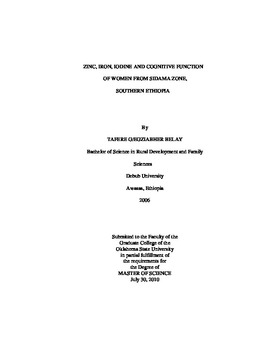| dc.contributor.advisor | Stoecker, Barbara J. | |
| dc.contributor.author | Belay, Tafere G/Egziabher | |
| dc.date.accessioned | 2014-04-15T22:00:56Z | |
| dc.date.available | 2014-04-15T22:00:56Z | |
| dc.date.issued | 2010-07-01 | |
| dc.identifier.uri | https://hdl.handle.net/11244/9208 | |
| dc.description.abstract | The purpose of the study was examine zinc, iron, and iodine status and their relation to cognitive function of women. A cross-sectional convenience sample of 202 women from three adjoining subsistence farming communities participated in the study. Socioeconomic and demographic data were collected by questionnaire, and height,weight and mid upper arm circumference were measured. Selected cognitive tests from the Kaufman's Assessment Battery for Children-II and the Raven's CPM were administered. Blood samples were analyzed for hemoglobin, ferritin, zinc and inflammatory markers. Urinary iodine excretion was measured and total goiter was determined by palpation. The self - reported age of the women was 30.8 (7.8) years. Mean household size and number of children was 6.1(2.4) and 4.2 (2.2) respectively. Of the participants 63.5% had no formal education. Women who had BMI < 18.5 were 25%. The biochemical analysis showed 52.6% had plasma zinc < 70 g/dL, 22% had depleted iron stores, that is ferritin level < 12 g/L, 22.78% had UIE < 20 g/L. Their mean hemoglobin 13.7 g/dL and median UIE was 37.7 g/L. The palpation-based goiter assessment showed 15.9% had goiter. No significant correlation was found between ferritin and all of the cognitive tests but UIE was correlated with Sequential (r = 0.15, p ≤ .05), simultaneous (r = 0.14, p ≤ .05) and Raven's CPM (r = 0.14, p ≤ 0.05). Plasma zinc level was negatively correlated with Raven's CPM and planning measures (r = -0.15, p ≤ .05). Strong significant correlations were observed between education of the women and all of the cognitive tests employed (p ≤ 0.001). Economic level based on a wealth index was significantly associated with sequential (r = 0.18, p ≤ 0.01), planning measures (r = 0.16, p ≤ 0.01) and Raven's CPM (r= 0.19, p ≤ .01). Significant differences among the three study areas were observed. Our regression model indicated that education enhanced cognitive test results; iron and iodine deficiencies contributed to impaired cognition but zinc deficiency did not. None of the study participants had consumed iodized salt and iodine deficiency is a public health problem in the study population. | |
| dc.format | application/pdf | |
| dc.language | en_US | |
| dc.publisher | Oklahoma State University | |
| dc.rights | Copyright is held by the author who has granted the Oklahoma State University Library the non-exclusive right to share this material in its institutional repository. Contact Digital Library Services at lib-dls@okstate.edu or 405-744-9161 for the permission policy on the use, reproduction or distribution of this material. | |
| dc.title | Zinc, Iron, Iodine and Cognitive Function of Women from Sidama Zone, Southern Ethiopia | |
| dc.type | text | |
| dc.contributor.committeeMember | Kennedy, Tay S. | |
| dc.contributor.committeeMember | Thomas, David G. | |
| dc.contributor.committeeMember | Hubbs-Tait, Laura E. | |
| osu.filename | Belay_okstate_0664M_11050.pdf | |
| osu.college | Human Environmental Sciences | |
| osu.accesstype | Open Access | |
| dc.description.department | Department of Nutritional Sciences | |
| dc.type.genre | Thesis | |
| dc.subject.keywords | cognitive function | |
| dc.subject.keywords | ethiopia | |
| dc.subject.keywords | iodine | |
| dc.subject.keywords | iron | |
| dc.subject.keywords | sidama zone | |
| dc.subject.keywords | zinc | |
